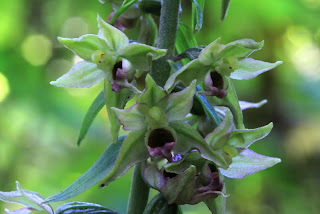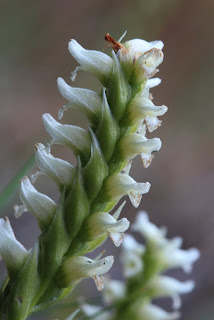August 4-10
Two excursions and lots of orchids this week. I went for an afternoon and visited some sites in Larrabee State Park south of Bellingham and found a lot of Epipactis helleborine, the Broad-leaved Helleborine. As I've noted before, this is not a native but has colonized the coastal areas of the park and seems to be everywhere. Due to its location along the railroad tracks, I believe that is how it probably came in, but it has spread along many of the trails and I suspect that foot traffic is the way it's spread. Some call it a weed, but it is a rather attractive weed nonetheless.
I found not only the normally colored form varying from green and purple to green and pink, but also found the green-flowered form, Epipactis hellebronie fma. viridens. The species has several other color forms as well with yellow or white flowers. Many of the plants I found, however, had unusually small flowers, some less than 2cm (approximately a half inch) and very tightly packed on the stems. I suspect this is due to a very dry summer which also probably limited the number of plants, since I did not find as many as I expected, even though I visited a number of sites.
In those same areas we found two Platantheras still blooming, Platanthera dilatata var. dilatata, the Tall White Northern Bog Orchis, was still blooming. It is distinguished from the other varieties of this species by a spur that is approximately the same length as the lip. With it was blooming the ubiquitous Platanthera stricta, the Slender Bog Orchis, found in every wet ditch in the Cascades at this time of the year. Both of these species were finished at lower elevations and even at these highest elevations showed signs of the fact that they would soon be finished.
We also found one plant of what appeared to be a natural hybrid of Platanthera stricta and one of the varieties of Platanthera dilatata, with the color and lip of the former species and the spur of the latter. What the name of this hybrid would be I am not sure, but the hybrid of another variety of Platanthera dilatata and Platanthera stricta is known as Platanthera xestesii, Estes Hybrid Rein Orchis. The green Platantheras are infinitely variable, however, and intergrade with one another and so I am not at all sure what exactly we saw or even whether this is indeed a natural hybrid.
.


















































8 comments:
the macros of the dew covered romanzoffiana are fantastic
they look like something a candy maker would come up with
Thanks, Marti. They were pretty fantastic. There's a really good show of them up between Rainy Pass and Washington Pass in the open fields along the highway - well worth going to see. The plants at Diable Lake Overlook are finished.
Fantastic photos, beautiful and fruitful trip. Cool the Spiranthes, here now just the S. aestivalis and autumn bloom the S. spiralis. Hugs
Thanks for looking and commenting, my friend. Would love to see the Spiranthes species you have there.
I agree. Those pictures really stand out.
Our season is almost through, with the exception of Spiranthes spiralis, which is expected to peak in mid-september. Quite late this year due to the dry July.
Thanks, Martin, as always, for looking and commenting. The Spiranthes here will not be finished either until September, but they will be past their peak very soon. We had the opposite, a very early season because of the dry summer. Ordinarily we'd be seeing the Spiranthes and Piperias at the higher elevations well into September.
Wonderful photos, Ron! I'd love to visit for a couple of weeks out there. You have so many species that I've never photographed...
Jim Fowler, Greenville, SC
Jim, if you come out here we would be more than happy to show you around and even put you up if you need a place. Just let us know when you're coming!
Post a Comment